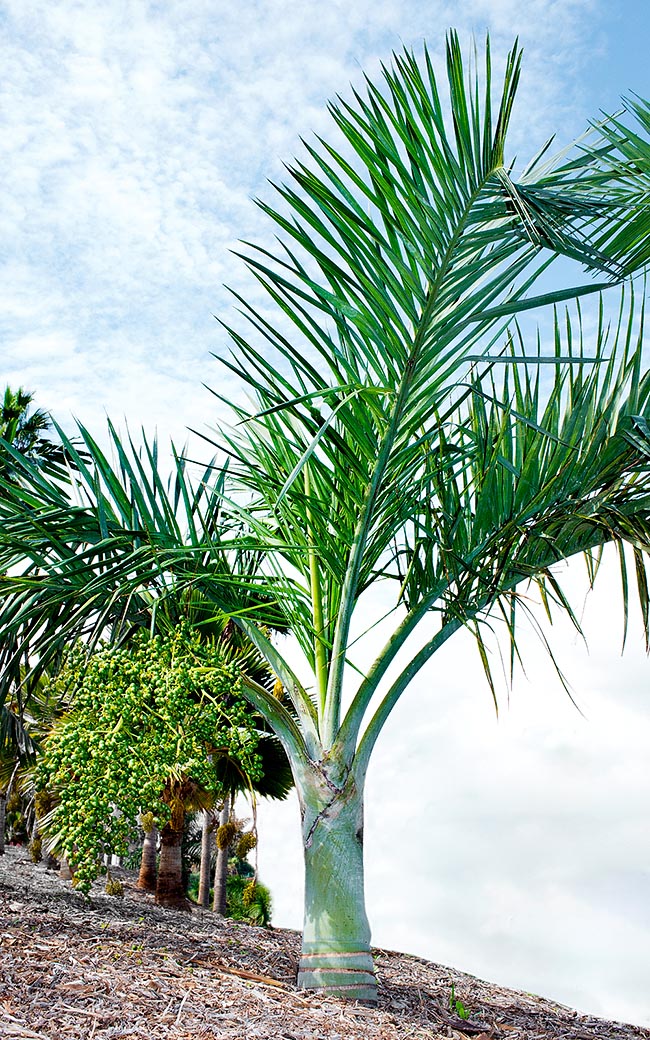Family : Arecaceae

Text © Pietro Puccio

English translation by Mario Beltramini
The species is native to Bahamas, Belize, Cuba, Dominican Republic, Haiti, Mexico (Campeche, Quintana Roo and Yucatan), Puerto Rico, Turks and Caicos Islands, USA (Florida) and Windward Islands, where it lives in the open and dry forests, mainly along the coasts, on sandy or calcareous rocky soils.
The name of the genus is the combination of the Greek prefix “ψευδο-“ (pseudo-) = false and of the genus Phoenix, because of the supposed similarity of the two genera; the species is dedicated to the American botanist Charles Sprague Sargent (1841-1927), founder and director of the Arnold Arboretum of Harvard University, as well as collector of the species type.
Common names: buccaneer palm, cherry palm, Florida cherry palm, hog palm, Sargent’s cherry palm (English); palma de guinea, palma de Santa Lucia (Cuba); kuká (Mexico); cacheo, catey ( Dominican Republic).

Native to Caribbean area, Pseudophoenix sargentii is an endangered species and little cultivated as slow growing © Giuseppe Mazza
The Pseudophoenix sargentii H.Wendl. ex Sarg. (1886) is a solitary species, monoecious, unarmed, with erect stem, 1-9 m tall and of 12-25 cm of diameter, slightly enlarged at the base and at times in the central part, greyish and covered by a waxy patina in the youngest part on which stand out the prominent brownish foliar scars.
The leaves, on a 0,3-1 m long petiole, are pinnate curved, 1,2-2,3 m long, with lanceolate leaflets with acuminate apex, irregularly arranged along the rachis at different angles, 30-50 cm long and 2-4 cm broad in the central part, of green grey colour and covered by a glaucous waxy patina with brown scales (ramenta) along the central vein in the lower page; the foliar base, 20-40 cm long, fissured on the opposite side to the petiole and covered by a glaucous waxy patina, entirely embraces the stem only for a short tract.
Inflorescences erect or curved between the leaves, with ramifications up to the fifth order, 0,9-1,7 m long, of yellowish green colour, with hermaphrodite flowers spirally arranged with 6 stamens and trilocular gynoecium with sessile stigma, except in the terminal part where are present only male flowers. Globose or 2-3 lobate fruits, of 1,2-1,7 cm of diameter, of bright red color when ripe, containing 1-3 seeds.
It reproduces by seed, previously kept in water for 3 days, in sandy loam maintained slightly humid at the temperature of 26-28 °C, with germination times starting from 2-3 months. The fruits are to be carefully handled due to the presence of raphides of calcium oxalate that can cause dermatites to the most sensitive individuals.
Species of considerable ornamental value, but little diffused in cultivation because of it relatively slow growth even in the most favourable conditions.
Due to the relatively contained dimensions it may be advantageously utilized even in gardens of modest size in the tropical, subtropical, and mildest warm temperate regions, where it can stand exceptional temperature values just less than 0 °C, but little tolerates the long periods of relatively low temperatures that can be met, for instance, in the Mediterranean climates. Requires full sun and adapts to various types of soil, provided perfectly draining, also moderately salty, therefore can be employed close to the sea, it resists furthermore to the strong winds, and, well rooted, to dry periods.
Synonyms: Chamaephoenix sargentii (H.Wendl. ex Sarg.) Curtiss (1887); Cyclospathe northropii O.F.Cook (1902); Pseudophoenix linearis O.F.Cook (1923); Pseudophoenix saonae O.F.Cook (1923); Pseudophoenix gracilis Ekman ex Burret (1929); Pseudophoenix navassana Ekman ex Burret (1929); Pseudophoenix sargentii var. navassana (Ekman ex Burret) Read (1968); Pseudophoenix sargentii subsp. saonae (O.F.Cook) Read (1968).
